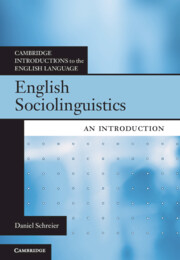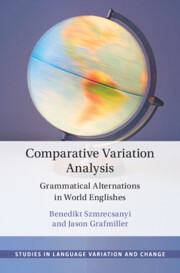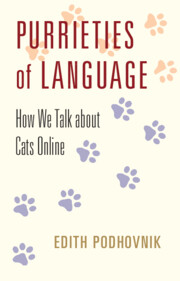Refine search
Actions for selected content:
45 results
4 - The Geography of English in England
- from Part I - The Context of English
-
-
- Book:
- The New Cambridge History of the English Language
- Published online:
- 30 October 2025
- Print publication:
- 30 October 2025, pp 99-129
-
- Chapter
- Export citation
5 - Philology and the History of English
- from Part I - The Context of English
-
-
- Book:
- The New Cambridge History of the English Language
- Published online:
- 30 October 2025
- Print publication:
- 30 October 2025, pp 130-162
-
- Chapter
- Export citation
5 - English Manuscript Traditions
- from Part I - The Textual Record
-
-
- Book:
- The New Cambridge History of the English Language
- Published online:
- 18 October 2025
- Print publication:
- 16 October 2025, pp 127-153
-
- Chapter
- Export citation
A PAT- on the back?: “Invisible” borrowing in Guernésiais
-
- Journal:
- Journal of French Language Studies / Volume 35 / 2025
- Published online by Cambridge University Press:
- 03 July 2025, e11
-
- Article
-
- You have access
- Open access
- HTML
- Export citation

English Sociolinguistics
- An Introduction
-
- Published online:
- 01 May 2025
- Print publication:
- 15 May 2025
-
- Textbook
- Export citation
The Scale of Northern-ness: How perceptions of local geography and ‘posh-ness’ affect local dialect recognition close to the North/Midland border of England
-
- Journal:
- English Today / Volume 41 / Issue 1 / March 2025
- Published online by Cambridge University Press:
- 30 January 2025, pp. 35-40
- Print publication:
- March 2025
-
- Article
- Export citation
Visualizing map data for linguistics using ggplot2: A tutorial with examples from dialectology and typology
-
- Journal:
- Journal of Linguistic Geography / Volume 12 / Issue 2 / October 2024
- Published online by Cambridge University Press:
- 30 January 2025, pp. 69-83
-
- Article
-
- You have access
- Open access
- HTML
- Export citation
4 - Grammatical Variation in England
- from Part I - English
-
-
- Book:
- Language in Britain and Ireland
- Published online:
- 17 October 2024
- Print publication:
- 31 October 2024, pp 98-127
-
- Chapter
- Export citation
28 - Dialectal Fragmentation
- from Part 5 - Sociolinguistic and Geographical Approaches
-
-
- Book:
- The Cambridge Handbook of Slavic Linguistics
- Published online:
- 16 May 2024
- Print publication:
- 23 May 2024, pp 595-625
-
- Chapter
- Export citation
1 - Introduction
-
- Book:
- Comparative Variation Analysis
- Published online:
- 24 August 2023
- Print publication:
- 07 September 2023, pp 1-11
-
- Chapter
- Export citation

Comparative Variation Analysis
- Grammatical Alternations in World Englishes
-
- Published online:
- 24 August 2023
- Print publication:
- 07 September 2023
9 - Linguistic Scratching Posts
-
- Book:
- Purrieties of Language
- Published online:
- 06 April 2023
- Print publication:
- 27 April 2023, pp 221-252
-
- Chapter
- Export citation
2 - The Feline Territory of Language
-
- Book:
- Purrieties of Language
- Published online:
- 06 April 2023
- Print publication:
- 27 April 2023, pp 24-60
-
- Chapter
- Export citation

Purrieties of Language
- How We Talk about Cats Online
-
- Published online:
- 06 April 2023
- Print publication:
- 27 April 2023
Auxiliary Selection in Yiddish Dialects
-
- Journal:
- Journal of Germanic Linguistics / Volume 34 / Issue 4 / December 2022
- Published online by Cambridge University Press:
- 14 November 2022, pp. 341-384
-
- Article
- Export citation
Subject relative who in Ontario, Canada: Change from above in a transplanted ecology
-
- Journal:
- Journal of Linguistic Geography / Volume 11 / Issue 1 / April 2023
- Published online by Cambridge University Press:
- 28 October 2022, pp. 25-37
-
- Article
-
- You have access
- Open access
- HTML
- Export citation
Decline and substitution of Spanish future subjunctive in northwest and southwest Colombia from the sixteenth to the nineteenth centuries
-
- Journal:
- Journal of Linguistic Geography / Volume 10 / Issue 2 / October 2022
- Published online by Cambridge University Press:
- 15 August 2022, pp. 130-148
-
- Article
-
- You have access
- Open access
- HTML
- Export citation
Wright about Wight: A dialect glossary of the Isle of Wight based on EDD Online
-
- Journal:
- Journal of Linguistic Geography / Volume 10 / Issue 2 / October 2022
- Published online by Cambridge University Press:
- 01 August 2022, pp. 76-86
-
- Article
-
- You have access
- Open access
- HTML
- Export citation
8 - Spatial Variation
-
- Book:
- Arabic Sociolinguistics
- Published online:
- 01 July 2022
- Print publication:
- 07 July 2022, pp 156-188
-
- Chapter
- Export citation
1 - Introduction
-
- Book:
- Arabic Sociolinguistics
- Published online:
- 01 July 2022
- Print publication:
- 07 July 2022, pp 1-8
-
- Chapter
- Export citation
